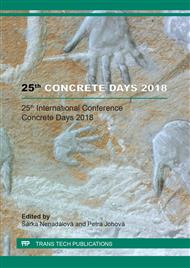[1]
Ytong - An overview of material characteristics and products. [online]. (in Czech).
Google Scholar
[2]
PyroSim User Manual. Thunderhead Engineering, (2018).
Google Scholar
[3]
M. Adelzadeh, H. Hajiloo, and M. F. Green. Numerical Study of FRP Reinforced Concrete Slabs at Elevated Temperature. Polymers, 6(2):408-422, (2014).
DOI: 10.3390/polym6020408
Google Scholar
[4]
S. M. Allam, H. M. F. Elbakry, and A. G. Rabeai. Behavior of one-way reinforced concrete slabs subjected to fire. Alexandria Engineering Journal, 52(4):749-761, (2013).
DOI: 10.1016/j.aej.2013.09.004
Google Scholar
[5]
A. Balaji, P. Nagarajan, and T. M. M. Pillai. Predicting the response of reinforced concrete slab exposed to fire and validation with IS456 (2000) and Eurocode 2 (2004) provisions. Alexandria Engineering Journal, 55(3):2699-2707, (2016).
DOI: 10.1016/j.aej.2016.06.005
Google Scholar
[6]
M. Benýšek and R. Štefan. FMC - Fire Models Calculator. CTU in Prague, (2015).
Google Scholar
[7]
A. H. Buchanan. Structural Design for Fire Safety. Wiley, (2002).
Google Scholar
[8]
S. Chen, Y. Zhang, and A. Ren. A simple method for combining fire and structural models and its application to fire safety evaluation. Automation in Construction, 87:39-48, (2018).
DOI: 10.1016/j.autcon.2017.12.015
Google Scholar
[9]
K. Chudyba and S. Serega. Structural fire design methods for reinforced concrete members. Technical Transactions Civil Engineering, 110(1-B):15-36, (2013).
Google Scholar
[10]
M. Cvetkovska, M. Knezevic, Q. Xu, C. Chifliganec, M. Lazarevska, and A. T. Gavriloska. Fire scenario influence on fire resistance of reinforced concrete frame structure. Procedia Engineering, 211:28-35, (2018).
DOI: 10.1016/j.proeng.2017.12.134
Google Scholar
[11]
M. S. Dimia, M. Geunfoud, T. Gernay, and J.-M. Franssen. Collapse of concrete columns during and after the cooling phase of a fire. Journal of Fire Protection Engineering, 21(4):245-263, (2011).
DOI: 10.1177/1042391511423451
Google Scholar
[12]
EN 1991-1-2. Eurocode 1: Actions on structures - Part 1-2: General actions - Actions on structures exposed to fire. CEN, (2002).
DOI: 10.1002/9783433601570.oth1
Google Scholar
[13]
EN 1992-1-1. Eurocode 2: Design of concrete structures - Part 1-1: General rules and rules for buildings. CEN, (2004).
Google Scholar
[14]
EN 1992-1-2. Eurocode 2: Design of concrete structures - Part 1-2: General rules - Structural fire design. CEN, (2004).
Google Scholar
[15]
G. P. Forney. Smokeview, A Tool for Visualizing Fire Dynamics Simulation Data, Volume I: User's Guide. NIST Special Publication 1017-1, Sixth Edition, (2018).
DOI: 10.6028/nist.sp.1017-3
Google Scholar
[16]
K. Hertz. Documentation for Calculations of Standard Fire Resistance of Slabs and Walls of Concrete with Expanded Clay Aggregate. Report BYG DTU R-048, (2002).
Google Scholar
[17]
T. Lánský. Assessment of Fire Resistance of Concrete Structures with the Use of Different Fire Models. Student project, CTU in Prague, 2018. (in Czech).
Google Scholar
[18]
A. Levesque. Fire Performance of Reinforced Concrete Slabs. Master's thesis, Worcester Polytechnic Institute, 2006.[19] MATLAB. Version 8.6.0 (R2015b). The MathWorks, Inc., Natick, Massachusetts, United States, (2015).
Google Scholar
[20]
K. McGrattan, S. Hostikka, R. McDermott, J. Floyd, and M. Vanella. Fire Dynamics Simulator User's Guide. NIST Special Publication 1019, Sixth Edition, (2018).
Google Scholar
[21]
E. Nigro, G. Cefarelli, A. Bilotta, G. Manfredi, and E. Cosenza. Guidelines for flexural resistance of FRP reinforced concrete slabs and beams in fire. Composites Part B: Engineering, 58:103-112, (2014).
DOI: 10.1016/j.compositesb.2013.10.007
Google Scholar
[22]
R. D. Peacock, P. A. Reneke, and G. P. Forney. CFAST - Consolidated Model of Fire Growth and Smoke Transport (Version 7), Volume 2: User's Guide. NIST Technical Note 1889v2, (2017).
DOI: 10.6028/nist.tn.1889v1
Google Scholar
[23]
F. Pesavento, M. Pachera, P. Brunello, and B. A. Schrefler. Concrete exposed to fire: From fire scenario to structural response. In Concrete under Severe Conditions - Environment and Loading, volume 711 of Key Engineering Materials, pages 556-563. Trans Tech Publications, (2016).
DOI: 10.4028/www.scientific.net/kem.711.556
Google Scholar
[24]
L. T. Phan, T. P. McAllister, J. L. Gross, and M. J. Hurley. Best Practice Guidelines for Structural Fire Resistance Design of Concrete and Steel Buildings. NIST Technical Note 1681, (2010).
DOI: 10.6028/nist.tn.1681
Google Scholar
[25]
J. A. Purkiss. Fire safety engineering, Design of structures. Elsevier. Butterworth-Heinemann, 2nd edition, (2007).
Google Scholar
[26]
J. Rigberth. Simplified Design of Fire Exposed Concrete Beams and Columns. An Evaluation of Eurocode and Swedish Building Code Against Advanced Computer Models. Department of Fire Safety Engineering Lund University, Sweden, (2000).
Google Scholar
[27]
A. Sadaoui, A. Khennane, and M. Fafard. Fire resistance analysis of RC elements with restrained thermal elongation in a natural fire. In Computational Modelling of Concrete Structures, pages 603-608. CRC Press, (2014).
DOI: 10.1201/b16645-68
Google Scholar
[28]
R. Štefan. Transport Processes in Concrete at High Temperatures. Mathematical Modelling and Engineering Applications with Focus on Concrete Spalling. PhD thesis, CTU in Prague, (2015).
Google Scholar
[29]
R. Štefan and M. Benýšek. DataPlot - Tool for visualization of csv data. CTU in Prague, (2017).
Google Scholar
[30]
R. Štefan and J. Procházka. TempAnalysis - Computer program for temperature analysis of cross-sections exposed to fire. CTU in Prague., (2009).
Google Scholar
[31]
R. Štefan, J. Procházka, J. Novák, J. Fládr, F. Wald, A. Kohoutková, L. Scheinherrová, and M. Čáchová. Heat transfer in hybrid fibre reinforced concrete-steel composite column exposed to a gas-fired radiant heater. IOP Conference Series: Materials Science and Engineering, 246(1):012050, (2017).
DOI: 10.1088/1757-899x/246/1/012050
Google Scholar
[32]
R. Štefan, J. Sura, J. Procházka, A. Kohoutková, and F. Wald. Numerical investigation of slender reinforced concrete and steel-concrete composite columns at normal and high temperatures using sectional analysis and moment-curvature approach. Submitted.
DOI: 10.1016/j.engstruct.2019.03.071
Google Scholar
[33]
H. F. B. Xavier. Analysis of Reinforced Concrete Frames Exposed to Fire. Based on Advanced Calculation Methods . Master's thesis, University of Porto, FEUP, (2009).
Google Scholar


